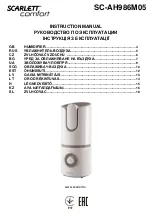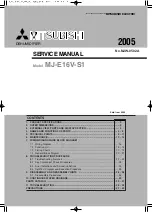
25
6.6 Start-up
6.6.1 Controller Settings
Set or verify settings on Controller. Detailed operational
points are presented in section 6.5.
WARNING - Enclosure may have live electric parts.
De-energize dryer before opening enclosure.
6.6.2 Initial Pressurization
SLOWLY
pressurize dryer to full line pressure. (If the
dryer was installed with inlet and outlet isolation valves,
the inlet isolation valve should be slowly opened while
the outlet isolation valve remains closed.)
During initial start-up, check the entire system for leaks.
If necessary, de-pressurize the dryer and correct any
leaks.
6.6.2.1 Energy Management Sensor (if installed)
Open and adjust the sample exhaust valve until a very
slight, continuous gas bleed is felt exhausting out of the
sample cell.
6.6.2.2 Dew Point Sensor (if installed)
Ensure that the supply air valve is open (one turn).
Open and adjust the sample exhaust valve until a very
slight, continuous gas bleed is felt exhausting out of the
sample cell.
6.6.3 Energizing the Dryer
Energize the dryer controls.
NOTE:
The switching failure alarm may be activated if the
unit is energized before it is pressurized. To deactivate
alarm, allow dryer to cycle to next step and press the
reset button.
6.6.4 Bringing the Dryer On-line
Establish a normal flow through the dryer. Slowly open
the outlet isolation valve if present. Close any dryer
bypass valves.
6.7 Operational Check Points
6.7.1 Power to unit
Check periodically that there is power to the unit
(indicating lights illuminated).
6.7.2 Alarms
Periodically check for flashing red alarm LED.
6.7.3 Tower Status LEDs
Illuminated LEDs indicate which tower is on-line drying
or off-line regenerating.
6.7.4 Tower Pressure Gauges
Periodically check tower pressure gauges to verify
that the pressure gauge of the on-line tower reads line
pressure and the pressure gauge of the off-line tower
reads below 2 psig (0.14 kgf/ cm
2
).
NOTE:
Read the off-line tower pressure gauge when the
tower is purging (air exhausting from muffler).
6.7.5 Process Valves
Determine if air control valves are operating and
sequencing correctly.
6.7.5.1 Valves – Models 500 and 600
Inlet switching valves are normally open, pneumatically
piston-actuated, Y-angle poppet valves. A yellow indicator
can be seen through a clear window at the top of the ac-
tuator housing when the valve is in the open position.
Purge exhaust valves are normally closed, pneumati-
cally piston-actuated, Y-angle poppet valves. A yellow
indicator can be seen through a clear window at the top
of the actuator housing when the valve is in the open
position.
12 volt DC, normally-closed, 3-way pilot solenoid valves
are wired to the controller and are used to direct pilot air
to the actuators of the inlet switching and purge/repres-
surization valves.
Dryers are equipped with a safety relief valve that has
been sized to provide overpressure protection due to a
fire for both desiccant towers.
6.7.5.2 Valves – Models 750 through 4300
Inlet switching valves are resilient seated butterfly valves
with double acting pneumatic rack and pinion actuators.
A yellow arrow indicator located on the top of the actuator
output shaft points to valve position indicator icons. Pilot
air is directed to actuator ports to open both inlet valves
upon loss of power.
(Model 750 only)
Purge exhaust valves are normally
closed, pneumatically piston-actuated, Y-angle poppet
valves. A yellow indicator can be seen through a clear
window at the top of the actuator housing when the valve
is in the open position.
(Models 900 through 4300)
Purge exhaust valves are
resilient seated butterfly valves with spring return, fail
closed, pneumatic rack and pinion actuators. A yellow
arrow indicator located on the top of the actuator output
shaft points to valve position indicator icons. Pilot air is
directed to actuator ports to close both purge/repres-
surization valves upon loss of power.
12 volt DC, single solenoid, 4-way pilot valves are wired
to the controller and are used to direct pilot air to the
actuators of the inlet switching and purge/repressuriza-
tion valves.
Two mainline outlet and two purge line check valves
are installed in the upper piping to control the flow of
outlet and purge air. Check valve sticking will result in
excessive air discharge through a muffler. Excessive air
discharge through the muffler can be associated with a
leaking outlet check valve on the same side or a purge
check valve of the opposite side tower.
Summary of Contents for Pneumatic Products IBP Series
Page 50: ......
















































